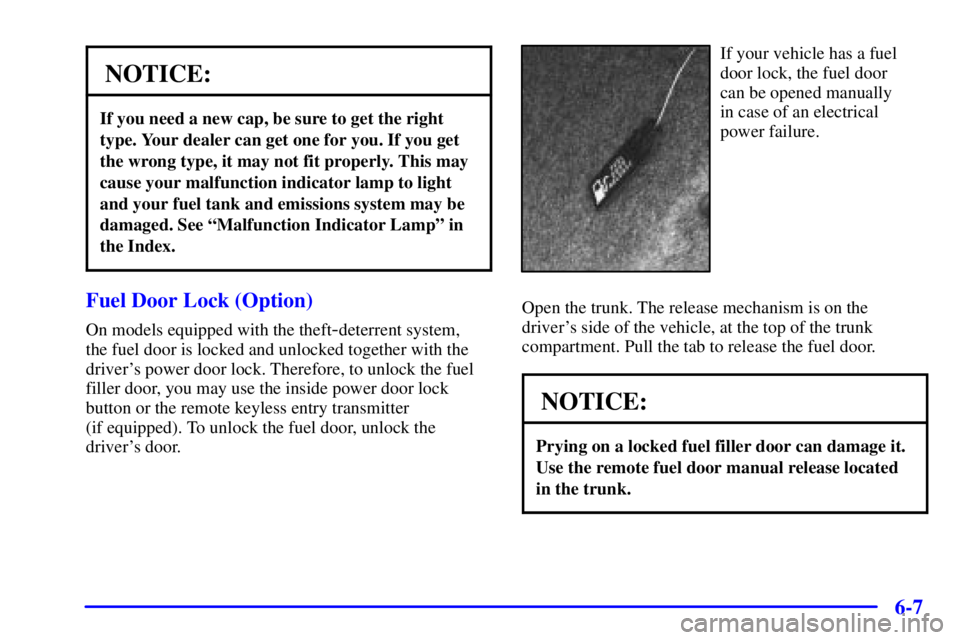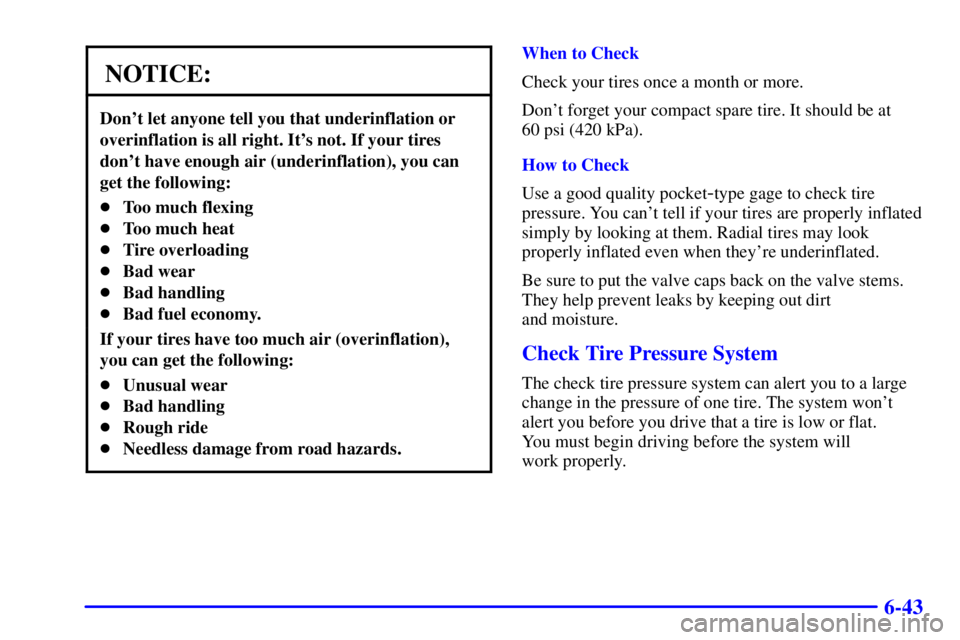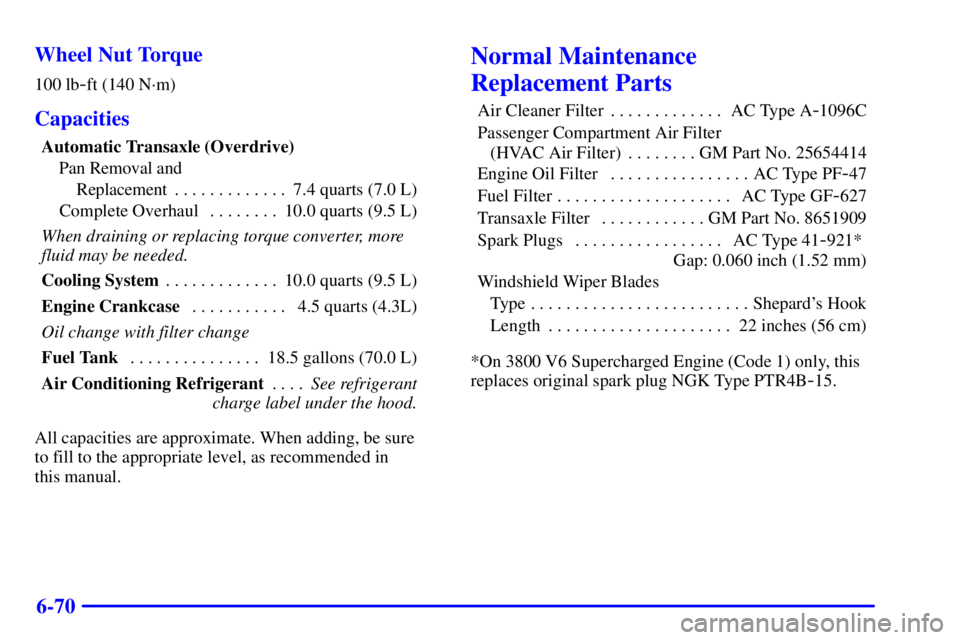Page 279 of 402

6-4
It is recommended that the gasoline meet specifications
which have been developed by the American Automobile
Manufacturers Association (AAMA) and endorsed by the
Canadian Motor Vehicle Manufacturers Association for
better vehicle performance and engine protection.
Gasolines meeting the AAMA specification could
provide improved driveability and emission control
system performance compared to other gasolines.
Be sure the posted octane for premium is at least 91
(at least 87 for regular). If the octane is less than 87,
you may get a heavy knocking noise when you drive.
If it's bad enough, it can damage your engine.
If your vehicle is certified to meet California Emission
Standards (indicated on the underhood emission control
label), it is designed to operate on fuels that meet
California specifications. If such fuels are not available
in states adopting California emissions standards, your
vehicle will operate satisfactorily on fuels meeting federal
specifications, but emission control system performance
may be affected. The malfunction indicator lamp on your
instrument panel may turn on and/or your vehicle may
fail a smog
-check test. (See ªMalfunction Indicator
Lampº in the Index.) If this occurs, return to your
authorized Pontiac dealer for diagnosis to determine the
cause of failure. In the event it is determined that the
cause of the condition is the type of fuels used, repairs
may not be covered by your warranty.Some gasolines that are not reformulated for low
emissions may contain an octane
-enhancing additive
called methylcyclopentadienyl manganese tricarbonyl
(MMT); ask your service station operator whether or
not the fuel contains MMT. General Motors does not
recommend the use of such gasolines. If fuels containing
MMT are used, spark plug life may be reduced and your
emission control system performance may be affected.
The malfunction indicator lamp on your instrument
panel may turn on. If this occurs, return to your
authorized Pontiac dealer for service.
To provide cleaner air, all gasolines in the United States
are now required to contain additives that will help
prevent deposits from forming in your engine and fuel
system, allowing your emission control system to
function properly. Therefore, you should not have to add
anything to the fuel. In addition, gasolines containing
oxygenates, such as ethers and ethanol, and
reformulated gasolines may be available in your area to
contribute to clean air. General Motors recommends that
you use these gasolines, particularly if they comply with
the specifications described earlier.
Page 282 of 402

6-7
NOTICE:
If you need a new cap, be sure to get the right
type. Your dealer can get one for you. If you get
the wrong type, it may not fit properly. This may
cause your malfunction indicator lamp to light
and your fuel tank and emissions system may be
damaged. See ªMalfunction Indicator Lampº in
the Index.
Fuel Door Lock (Option)
On models equipped with the theft-deterrent system,
the fuel door is locked and unlocked together with the
driver's power door lock. Therefore, to unlock the fuel
filler door, you may use the inside power door lock
button or the remote keyless entry transmitter
(if equipped). To unlock the fuel door, unlock the
driver's door.
If your vehicle has a fuel
door lock, the fuel door
can be opened manually
in case of an electrical
power failure.
Open the trunk. The release mechanism is on the
driver's side of the vehicle, at the top of the trunk
compartment. Pull the tab to release the fuel door.
NOTICE:
Prying on a locked fuel filler door can damage it.
Use the remote fuel door manual release located
in the trunk.
Page 318 of 402

6-43
NOTICE:
Don't let anyone tell you that underinflation or
overinflation is all right. It's not. If your tires
don't have enough air (underinflation), you can
get the following:
�Too much flexing
�Too much heat
�Tire overloading
�Bad wear
�Bad handling
�Bad fuel economy.
If your tires have too much air (overinflation),
you can get the following:
�Unusual wear
�Bad handling
�Rough ride
�Needless damage from road hazards.
When to Check
Check your tires once a month or more.
Don't forget your compact spare tire. It should be at
60 psi (420 kPa).
How to Check
Use a good quality pocket
-type gage to check tire
pressure. You can't tell if your tires are properly inflated
simply by looking at them. Radial tires may look
properly inflated even when they're underinflated.
Be sure to put the valve caps back on the valve stems.
They help prevent leaks by keeping out dirt
and moisture.
Check Tire Pressure System
The check tire pressure system can alert you to a large
change in the pressure of one tire. The system won't
alert you before you drive that a tire is low or flat.
You must begin driving before the system will
work properly.
Page 345 of 402

6-70 Wheel Nut Torque
100 lb-ft (140 N´m)
Capacities
Automatic Transaxle (Overdrive)
Pan Removal and
Replacement7.4 quarts (7.0 L) . . . . . . . . . . . . .
Complete Overhaul 10.0 quarts (9.5 L). . . . . . . .
When draining or replacing torque converter, more
fluid may be needed.
Cooling System10.0 quarts (9.5 L) . . . . . . . . . . . . .
Engine Crankcase4.5 quarts (4.3L) . . . . . . . . . . .
Oil change with filter change
Fuel Tank18.5 gallons (70.0 L) . . . . . . . . . . . . . . .
Air Conditioning RefrigerantSee refrigerant . . . .
charge label under the hood.
All capacities are approximate. When adding, be sure
to fill to the appropriate level, as recommended in
this manual.
Normal Maintenance
Replacement Parts
Air Cleaner Filter AC Type A-1096C . . . . . . . . . . . . .
Passenger Compartment Air Filter
(HVAC Air Filter) GM Part No. 25654414. . . . . . . .
Engine Oil Filter AC Type PF
-47 . . . . . . . . . . . . . . . .
Fuel Filter AC Type GF
-627 . . . . . . . . . . . . . . . . . . . .
Transaxle Filter GM Part No. 8651909. . . . . . . . . . . .
Spark Plugs AC Type 41
-921* . . . . . . . . . . . . . . . . .
Gap: 0.060 inch (1.52 mm)
Windshield Wiper Blades
Type Shepard's Hook. . . . . . . . . . . . . . . . . . . . . . . . .
Length 22 inches (56 cm). . . . . . . . . . . . . . . . . . . . .
*On 3800 V6 Supercharged Engine (Code 1) only, this
replaces original spark plug NGK Type PTR4B
-15.